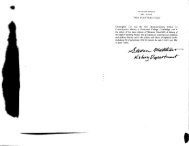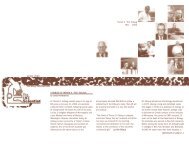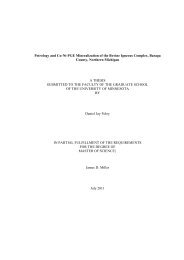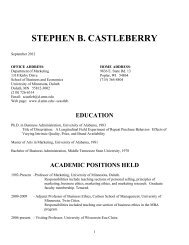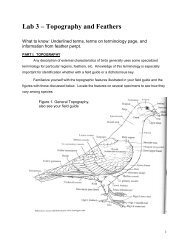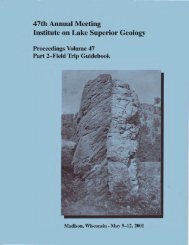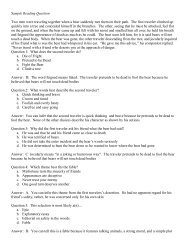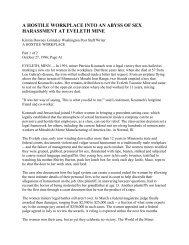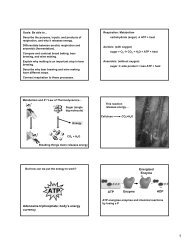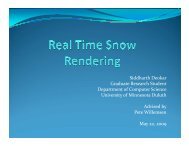Program, Abstracts, and Guidebooks - University of Minnesota Duluth
Program, Abstracts, and Guidebooks - University of Minnesota Duluth
Program, Abstracts, and Guidebooks - University of Minnesota Duluth
Create successful ePaper yourself
Turn your PDF publications into a flip-book with our unique Google optimized e-Paper software.
—55—<br />
Morey notes that sediment transport was from the north <strong>and</strong> that<br />
material was derived from Archean granite, gneiss <strong>and</strong> greenstone.<br />
PALEOHELIKIAN<br />
Siby Group<br />
he Sibley Group is a red bed sequence, deposited 1298±33 million<br />
years ago (Rb—Sr whole rock isochron, Franklin, 1970) extending from<br />
the Sibley Peninsula north to Armstrong, Ontario, <strong>and</strong> east to Rossport.<br />
The seven units which compose the Sibley Group are<br />
(a) basal conglomerate<br />
(b) s<strong>and</strong>stone<br />
(c) s<strong>and</strong>y red muds tone<br />
(d) chert—stromatolite<br />
(e) limey red mudstone<br />
(f) purple mudstone<br />
(g) limestone<br />
Polymictic basal conglomerate lentils are most common on the<br />
western margin <strong>of</strong> Sibley outcrop. Locally derived Gunf lint taconite<br />
boulders are found where the Sibley overlies the Gunf lint, but gran—<br />
itic boulders prevail where the Sibley overlies Archean rock. Lentils<br />
range to 15 feet in thickness, <strong>and</strong> occur in pre—Sibley valleys.<br />
Cream, green, <strong>and</strong> pink s<strong>and</strong>stone forms the lowest semicontinuous<br />
unit <strong>of</strong> the Sibley Group, <strong>and</strong> attains a thickness in the basin margins<br />
<strong>of</strong> over 200 feet. Beds are poorly graded; ripple marks <strong>and</strong> cross<br />
beds are present throughout, but are common only in the eastern margin<br />
<strong>of</strong> sedimentation near Rossport. Beds are composed <strong>of</strong> 50 to 70 per<br />
cent quartz, up to 8 per cent chert, 5 per cent feldspar, <strong>and</strong> 5 per<br />
cent mica, cemented with calcite <strong>and</strong> minor barite. Syneresis cracks<br />
are common near Edward Isl<strong>and</strong>. At the top <strong>of</strong> the unit, interbedded<br />
s<strong>and</strong>stone <strong>and</strong> mudstone mark the beginning <strong>of</strong> the s<strong>and</strong>y red mudstone<br />
unit.<br />
The s<strong>and</strong>y red mudstone unit is composed <strong>of</strong> less than 50 per cent<br />
quartz <strong>and</strong> feldspar clasts, in a red hematite—carbonate—clay—feldspar<br />
matrix, <strong>and</strong> ranges to 300 feet thick near Rossport. Bedding is<br />
moderately well developed. Brecciation <strong>and</strong> s<strong>of</strong>t—sediment folding<br />
are common in this unit; chaotic conglomerate lentils are exposed in<br />
the western margin <strong>of</strong> outcrop near Dorion.<br />
In the area south <strong>and</strong> east <strong>of</strong> Nipigon, the s<strong>and</strong>y red mudstone<br />
is separated from the limey red mudstone by a thin, but laterally<br />
continuous, chert unit. To the north <strong>and</strong> west <strong>of</strong> Nipigon a stro—<br />
matolite unit may occupy the same position. The stromatolites exposed<br />
1<br />
using l.47x10U yr. Rb87 decay constant; using l.39x1011 yr.<br />
constant, age is 1376±33 m.y. The latter may be compared with the<br />
date <strong>of</strong> Faure <strong>and</strong> Kovach (1969).




